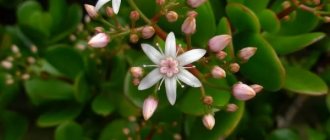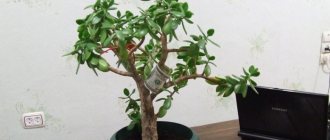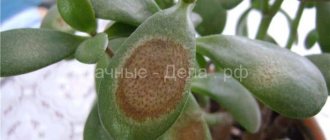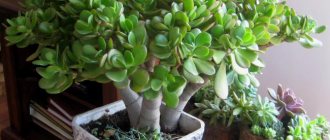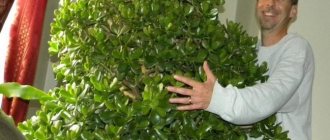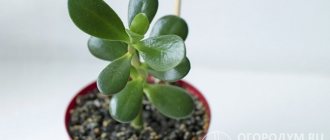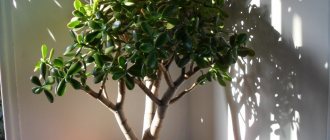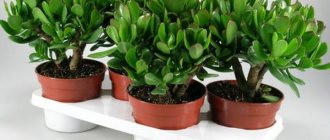An attractive succulent that is present in almost every apartment is the money tree. Other names for the plant are Crassula and Crassula. It fits harmoniously into any interior of the room, fills the space with positive energy and, according to legend, brings wealth to the house, which is why it is popular.
The money tree attracts financial well-being to the home
Types of money tree
The Crassula comes from the Crassula genus. The appearance of representatives of the class can vary greatly, depending on the subspecies. Plants can have not only a tree-like form with a clearly defined trunk, in which we are accustomed to seeing the money tree, which is popular among us. They often resemble a bush or have characteristics of ground cover and canopy forms.
Ampel-type money tree
There are even varieties in the genus for landscaping aquariums. But still, in our homes, it is precisely mini-trees with a thick trunk, burdened with signs of woodiness, and fleshy oval leaves that are lovingly grown. Today we will talk about the specifics of caring for this species.
Tree type money tree
The second name “crassula”: where did it come from?
The plant owes its name “crassula,” the second most popular among domestic flower growers, to the fleshy foliage that makes up its evergreen crown. Succulent leaves have the following characteristics:
- they are thick;
- round, like coins;
- consist of juicy pulp filled with moisture.
There is a legend that tells why the plant came to be called Crassula. In one village there lived a girl named Crassula. She was beautiful, but greedy. The beauty saved up gold coins, putting them in a jug. For this, the villagers called her a fat bag or a fat woman.
One day Crassula fell in love with a visiting young man, but could not leave with him. The jug with coins was too heavy, and the greedy girl was not ready to part with it for the sake of her beloved. Her chosen one, caught by the wind, became Perekatipol, and the beauty turned into a tree with coins instead of leaves.
Since then, a sign has appeared: in the house where there is a fat woman, there will always be money.
Basic secrets of proper care
Maintaining a money tree is not particularly difficult. The main thing is not to forget where this plant came to us from and to create optimal microclimatic conditions for it. To do this, you will need to know when the Crassula has active and passive life cycles. The growth period of the money tree falls in spring and summer, and the resting time is autumn and winter.
How to water
Since the money tree is a native of South Africa, it does not like moisture too much. During the period of activity, the fat plant is watered no more than twice a week. During rest - even less often. The guideline for the need to moisten the soil in a flowerpot should be its condition. The soil must be absolutely dry.
Overwatering is harmful to a money tree.
You shouldn’t overdry the soil either, but it’s still less dangerous than overwatering, which is really detrimental to the money tree. After watering, there should be no water left in the pan, so moisten the soil moderately.
Lighting
The role of light in the development of a plant is very important, but the scorching sun is completely contraindicated. The ideal place to place the pot would be the windowsill of a window facing southeast. There will be enough light there, and the sun coming in in the morning will not harm the leaves, due to its mild morning activity.
The money tree does not like direct sunlight.
During the warm period, the money tree can be sent to fresh air, for example, taken out to the balcony, but it would be better to place the pot with the plant on the floor so that the sun does not burn the crown. In winter, the fat plant should be moved to a south window.
In summer, the money tree can be taken outside
Soil and features of fertilizing at home
Since the money tree is a succulent (of this species the most popular among us are cacti), it also needs turf soil for good growth. If this is not available, you can use a universal primer.
It is preferable to plant a money tree in a turf post.
Experienced gardeners often independently select the soil composition, which includes:
1. 4 parts turf soil.
2. 1 part sand.
3. 1 part leaf soil.
4. 1 part humus.
It is necessary to arrange drainage at the bottom of the flowerpot. Pieces of coal and brick chips will cope well with this mission. Those who believe in the magical properties of the fat plant also place a few coins at the bottom of the pot.
Ready drainage for money tree
To feed when caring for the plant, use either universal fertilizers or specific additives intended for succulents. As with most plants, nutrients are added after watering. This way they are absorbed better.
Fertilizers for succulents are suitable for money trees.
In the summer, feed the money tree about once a month, during rest - once every couple of months.
Temperature
Crassula, in principle, does not particularly respond to temperature fluctuations. Despite its southern origin, the plant tolerates temperatures well even at +6o, but the money tree should not be placed specifically in such conditions. The optimal indicators for it will be +18o – +25o. In winter, the operating conditions may be slightly reduced, to 10-16o. When there are temperature changes, you need to monitor the appearance of the fat woman in order to promptly notice problems with its condition.
In winter, pay attention to the appearance of the money tree
Air humidity
The money tree does not need constant spraying. It is better to wipe its coin-like leaves with a damp cloth periodically, thus ridding them of settled dust
Wipe off any accumulated dust from the leaves of the money tree.
If the humidity indicators are not so important for the fat woman, then access to fresh air is simply necessary. Make sure that when ventilating, the plant does not get exposed to rampant drafts. It doesn't like it very much. On warm days, it makes sense to take the money tree out into the garden or onto an open balcony.
Money tree does not like drafts
Subtleties of choosing a flowerpot
When caring for a money tree, it is very important to choose the right “home” for it. A pot of the wrong size can not only slow down the growth of a seedling, but stop it altogether.
Crassula needs a stable, small height, wide pot. This is an ideal option for its shallow root system.
Low wide pot for money tree
The crown of the plant will help determine the width of the pot. The diameter of the flowerpot should be equal to or slightly exceed its spreading nature.
The diameter of the flowerpot should correspond to the width of the crown
Propagation by seeds and cuttings
It is not difficult to propagate Crassula at home. There are two ways to obtain a new plant: germination of seeds and rooting by cuttings and leaves.
The key to successful growth of Crassula is timely fertilization
Propagation using seeds
This process is considered labor-intensive and time-consuming. It is advisable to propagate seeds in February.
Description of the procedure:
- You need to pour the substrate into the bottom of a shallow but wide bowl and moisten it.
- Place the container itself in a room with a temperature of 20-25 degrees in a bright place.
- Place the seeds on the surface at a distance of 3-4 cm from each other and deepen them.
- The container must be covered with glass or polyethylene to achieve a greenhouse effect.
- Watering should be done using a spray bottle with water.
After the sprouts have become stronger, they are planted in separate containers. In the first year of life, the resting phase is excluded. The rest of the care is the same as for an adult money tree.
The formation of the plant crown is carried out by using two methods: pinching and pruning.
Propagation by cuttings and leaves
This method is considered the simplest and most popular. It is recommended to carry out the procedure in the spring. To grow, you will need to stock up on any cut twig; however, it must be separated from the trunk with a sterile instrument, and the cut area must be treated with charcoal. The cutting itself, after separation, should be left in the fresh air for several hours.
You can root a leaf or cutting in plain water with the addition of activated carbon or a moist substrate. To make the roots grow faster, it is recommended to create a greenhouse effect - to do this, cover the container with polyethylene.
To enhance the effect of the tree, you should tie red threads with coins on its branches
To moisturize, you will need to use a spray bottle, but the temperature of the liquid itself should be 20-24 degrees. From time to time it is necessary to ventilate the plant.
As soon as the first roots appear, the flower is planted in a pot with soil. Subsequently, care should be provided in the same way as for an adult tree.
The money tree can grow up to one and a half meters in width and height, but it reaches full size only at 10 years old - at this time flowering occurs.
Flowering money tree - myth or reality?
“Those who see a blooming money tree are guaranteed material profit.”
Those who have seen Crassula bloom can be classified as lucky. The plant does bloom, but it does so extremely rarely at home. Its buds are small, and the flower petals are most often light in color:
1. White and green.
White and green money tree flowers
2. White.
White flowers of the money tree
3. White and pink.
White and pink money tree flowers
The flowers exude a subtle sweet aroma. The flowering period is quite long and can last for several months. Naturally, it falls on the active phase in the life of the plant.
The flowering period of the money tree is quite long.
There is also a belief about this, akin to the story of the fern. Those who see a blooming money tree are guaranteed material profits.
There is a completely scientific explanation for why Crassula rarely blooms even with excellent care at home. The problem is the lack of daylight: in the tropics, daylight hours are much longer. So no mysticism!
The flowering of the money tree is quite a rare occurrence.
Decorative flowering crassulas
There are varieties of Crassula that are grown exclusively for decorative purposes. These are the plants that bloom every year.
Schmidt's Crassula
Refers to the ground cover variety. In European countries, the plant is considered an annual and is thrown away immediately after flowering.
The height of the bush is about 10 cm. The leaves are dense and lanceolate. Their shape is narrow with pointed ends. Color: green on top with a silvery coating, with a reddish tint on the back. The stem is greenish-pink. Blooms with red, carmine-colored flowers.
Justi Cordero
Annual flower. In appearance it is very similar to Schmidt's Crassula. The main difference is that the leaves are flattened, rounded below, and their edges are covered with thin cilia.
At the time of flowering, the plant produces variegated carmine buds. The inflorescences are red.
Rosaularis
One of the tallest (about 1 m) decorative succulents. Stems are straight, slightly branched.
The peculiarity of the flower is the leaves, which seem to be strung on the stem. They are juicy and meaty. The shape is triangular or lanceolate. Length 10–15 cm. The upper surface is densely strewn with red dots, and the edges are covered with small, barely noticeable teeth.
Peak flowering occurs in summer. The flowers are miniature, the inflorescences are cross-shaped. Color white or red. The peduncle grows 10 cm from the top of the stem.
Crescent
A subshrub with an erect stem that branches weakly. Height is about 1 m. Leaves are sickle-shaped. They are characterized by meatiness and juiciness. They grow together and wrap around the stem.
Crassula blooms at the end of summer with variegated red flowers with a carrot tint. They are collected at the top of the shoot, with a maximum diameter of 20 cm. The shape of the inflorescence is an umbrella.
The peculiarity of the variety is that after flowering, the top of the shoot is removed to form well-developed leaves. They wait for side shoots to appear, of which one, the most powerful, is left.
Crassula pierced-leaved
One of the tallest decorative succulents (height 1 m). Stems are straight, slightly branched. The arrangement of the leaves is unique - they seem to be strung on the stem. The plates are juicy and meaty. The shape can be triangular or lanceolate.
The upper surface of the leaves is densely strewn with red dots, and the edges are decorated with almost imperceptible small teeth. The plant blooms in summer with small flowers, which are collected in racemose inflorescences. Their color is white or red.
Is it possible to stimulate the flowering of the money tree?
“It has been noted that the Crassula loses its color after any stress.”
Expecting the Crassula to bloom due to excellent care in the first years of life is nonsense. At home, such a miracle can happen no earlier than in seven, or even ten years. Sometimes flowering does not occur at all, despite all the efforts of the gardener, but this is not a reason to give up.
Start moving towards your goal by following all the recommendations for caring for a money tree growing at home. Learn to recognize subtle changes in a plant's appearance.
The first flowering often occurs after 7 years
It was noted that the fat woman loses its color after any stress. Some create such situations for the plant intentionally, for a long time, without watering it or organizing an unacceptable temperature regime for it. The first watering after a dry period and getting into optimal conditions can produce the desired effect and, in gratitude for the salvation, the money tree will bloom. But is the game worth the candle? After all, your talisman may not withstand the test and simply die, taking with it your hopes for material well-being.
The difference between a wild plant and a house plant
In its natural habitat, Crassula is a large, highly branched, rounded evergreen shrub. Unlike its domestic counterparts, the flower reaches a height of 1-1.5 meters, but sometimes grows up to 5 meters !
Wild brothers of the Crassula are larger in size. Photo used as illustration. Source: Yandex.Images
In its native range, the Crassula is a prominent component of thickets of valley vegetation and is found on dry rocky slopes. In addition, Crassula grows in the Albany bush (woodland of South Africa), where grasses and mixed succulent plants of Aloe and Euphorbia predominate.
In some areas, the plant must cope with frequent droughts, unpredictable rainfall (250 to 550 millimeters of rain per year) and maximum temperatures in the region of 40°C. In arid coastal areas, the presence of hydathodes (devices for the plant to release moisture in the form of drops) on the leaves can be important for the absorption of water from coastal fog.
Money tree: transplantation and specifics of reproduction
The time to transplant the fat plant is spring. It is recommended to replant an adult individual annually, or at least every other season. The purchased seedling can be transferred to a new pot immediately after the end of the adaptation period. Its duration is usually two weeks.
It is recommended to replant the money tree annually.
Drainage is placed in a pot selected by size and soil is poured. The money tree seedling is “dumped” into a prepared container along with a lump of soil in the roots, after which the remaining voids are filled with fresh soil. Everything needs to be done carefully, trying not to damage the fragile branches and delicate leaves of young growth.
When transplanting, do not damage the young branches
If, during transplantation, you find rotten pieces of roots, you need to get rid of them by carefully cutting them off. The healthy part is dried and left to ventilate for a day without covering the roots.
Transfer
The money tree has a negative attitude towards procedures such as transplantation. Therefore, this activity is carried out only in cases of extreme necessity and with extreme caution.
- Young seedlings should be replanted regularly in the spring, as they grow quickly and require a larger pot. Purchased plants should also be replanted in order to improve the soil and container, but only after a period of acclimatization in the new place (2 weeks). Adult trees are subjected to this procedure as they grow, but not more often than after 3 years.
- Transplantation is carried out at the beginning of the growing season, that is, in the spring. Due to the strong fragility of the branches and the weak, fragile root system, the procedure is carried out using transfer methods: the plant is carefully removed from the old pot and, together with a lump of earth on the roots, is transferred to a new container, then fresh soil is added and slightly compacted around the edges.
- To better adapt the tree to the new soil, you should not deepen the trunk too much - the surface of the earth should remain at the same level so that the root collar is not damaged.
- Since the soil gradually deteriorates, it must be completely changed periodically. To do this, the roots are carefully cleared of soil, inspected and cut if necessary (all cuts are treated with activated carbon) and placed in a new substrate. After transplanting, water and place in a cool place for a week or two.
Attention! “ Money tree” is characterized by a weak root system that does not correspond to the volumetric crown. Therefore, when replanting, it is necessary to choose a wide, weighty pot with a stable bottom and fill it with heavy drainage pebbles. This will prevent the plant from tipping over and breaking.
How to grow a money tree from scratch
You can get a healthy seedling from seeds and cuttings.
Money Tree Seeds
Seeds are sown in ordinary clay pots with a suitable soil mixture. They don't sow deeply. The pot is covered with film (can be glass), creating greenhouse conditions. Care consists of regular half-hour ventilation, which is organized for the crops daily, and spraying the soil with water, which is carried out as the top layer dries. Sprouts will appear in the third week.
money tree sprouts
It is much easier to propagate Crassula by cuttings. They can, bypassing the stage of settling in water, be immediately sent to prepared soil. For rooting, the cuttings are deepened by 6 cm. The best period for propagation is the month of March. It was noted that plants planted at this time have a greater chance of blooming in the future. Planting a money tree cutting in July significantly reduces the likelihood of flowering.
Propagation of money tree by cuttings
Interesting facts and useful information about indoor plants
In addition to the magical properties attributed to the Crassula, it has a number of unique characteristics:
- the plant can be easily propagated using stem or leaf cuttings;
- when grown in good lighting, the leaves may turn red;
- This South African succulent doesn't need much attention;
- in most countries, a Money Tree is given as a gift for a wedding, housewarming, or when launching a new business;
- the plant tolerates a wide range of humidity and temperature, and even light frosts;
- The mode of watering a flower depends on three things: microclimate, soil and pot capacity.
Crown care
The money tree is a rare representative of domestic plants, the crown of which can be formed into various shapes.
Topping
Basically, the owners of the fat plant do not consider it necessary to pinch its shoots, because at home the plant does not branch very actively. Their branches are often long, thin and simply do not have time to become lignified. But that's the problem. Thinning branches are not able to carry the load of fairly heavy leaves, so they begin to bend downwards and possibly even break off. It happens that the crown turns over the entire pot with its weight, mercilessly breaking the already formed tree. Pinching can prevent unwanted excesses.
Pinching the money tree
Features of formation
The classic form of Crassula is considered to be the type of tree. To help the crown form in such an image, you need to follow several rules. First of all, the money tree should grow in a pot in a single copy. Planting several seedlings in one container will lead to the appearance of a jungle of weak shoots that will prevent each other from branching and getting stronger. In a single-growing tree, it is necessary to pinch the shoots in a timely manner, giving the crown the required shape.
To form a tree-like form, one plant is planted in a pot.
How to properly pinch
The time for pinching comes when at least four pairs of leaves appear on the branch, and a new bud has already appeared between the last ones. It is this that needs to be plucked. This is done with tweezers or nails, by pulling or twisting. It's convenient for anyone. The main task is not to damage nearby leaves. A little time will pass and several new ones will appear in place of the removed kidney. This will indicate that your money tree has begun to branch. In the case where a single bud appears, the pinching procedure is repeated.
Diagram of the formation of the crown of a money tree
It is very important to carry out the pinching procedure exactly at the specified level. By doing this lower, you will force the branches to grow cramped, while letting the branches grow higher will allow them to become thin and overloaded with foliage. In the latter case, the shoot will need to be shortened by breaking off or cutting off the upper part. The cut site is sprinkled with an antiseptic, which can be crushed activated carbon or powdered cinnamon. You cannot use wire in caring for the money tree at the stage of crown formation.
Bud to pinch off on a money tree
You need to start giving the plant the intended configuration from the first months of life. You can also form a crown on a fully grown plant. However, in this case you will have to remove pieces of branches. After such procedures, not very attractive stumps will remain, so it is better to work on the crown of the plant while it is still young.
Is it necessary to form a trunk?
This part of the money tree does not need your care. The leaves on the woody trunk will be needed by the fat plant until a certain time, so do not rush to remove them. Subsequently, she will shed them on her own, and the trunk will take on a magnificent appearance.
Money tree diseases
A plant, even if it is at home and has excellent care, can be affected by destructive diseases.
Most often, gardeners are alarmed by the appearance of discolored leaves that darken and fall off. This is evidence of fungal infection of the plant. Similar symptoms will appear when watering the fat plant with too cold water. The appearance of brown spots on the surface of the leaf indicates a lack of moisture.
Fungal infection of the money tree
Rot at the base of the trunk is a terrible signal. This is clear evidence of blooming root rot, the cause of which is excess moisture. To save the money tree, you will have to take radical measures - cut off the top and grow the plant again.
When the trunk rots, the top of the money tree is cut off
Pests often settle on the fat plant. They are impressed by the succulent leaves of the plant. Most often, the money tree is favored by mealybugs and spider mites. The fight against them is carried out using generally accepted means. You can remove their nesting sites with a cotton swab soaked in alcohol or with insecticides suitable for treating succulents.
Pests on money tree
Problems of keeping the Crassula
As a rule, problems arise when plant care either stops altogether, or it is not proper, and sometimes excessive.
The tree can shed its leaves at any time, which will indicate that there is no moisture at all or the tree has been watered with cold water. Water for irrigation should be at room temperature and not lower, and maybe several degrees higher.
You need to be especially careful when maintaining a tree in winter. During this period, it is very difficult to guess how much moisture it needs. If there is excess moisture, the leaves may wilt or turn pale, and if there is no moisture at all, they may darken, wrinkle and lose their shine.
Damaged leaves should be removed immediately and think about what happened: either watering should be stopped altogether, or watering should be done at least once. If an error occurs in one direction or another, then the money tree can be lost forever.
If there is little moisture, then brown spots may appear on the leaves. If the spots are brown but soft, then this is most likely a fungal disease and the plant needs to be treated with antifungal drugs.
If the plant is infected with root rot, it will begin to turn black from below. In this case, surgical intervention is possible: the plant should be removed from the pot, after which the damaged roots are cut out, and the tree is transplanted into a new pot and fresh substrate. Damaged roots may be such that the money tree may die. In this case, the top is cut off and rooted. In this way, a new tree will be grown.
If a tree grows with a long, ugly stem, then these are consequences due to winter waterlogging, as well as lack of lighting.
There are practically no pests in the fat plant if you care for it properly. In fact, any ornamental plant is not affected by pests if it is healthy and growing normally. And this only happens when the plant is given due attention. If, nevertheless, something suspicious appears on the tree, then it is better to treat the tree with chemicals.
It was noticed that the condition of the money tree directly depends on the psychophysical state of the person who cares for it. If a person gets sick, then something bad happens to the tree. There were cases when the tree even died.
Interesting facts about the money tree
Crassula is not only native to southern Africa; it grows in Madagascar and in some areas of Australia.
The age of a plant can be determined by the condition of its trunk and crown. The older it is, the more pronounced the woodiness and the more spreading the top.
The age of a money tree is determined by its trunk and leaves.
There are many legends and superstitions associated with the money tree. They say that if you want to get rich, you must have a fat girl in your house and look after it like a child, nurturing and nurturing it. Coins buried under the roots of a seedling will help improve your well-being.
They say that the tree can predict not only upcoming profits, but also upcoming problems. The indicator is the leaves that wrinkle and fall on the eve of a crisis and delight with the gloss of their surfaces in good times.
The money tree is considered an energy piggy bank. It is interconnected with the owner and when the latter is ill, it begins to accumulate negative energy on itself. The plant withers and sheds its leaves, but as soon as a person gets better, the tree will immediately perk up and come to life. So the good appearance of the fat woman is also evidence of the excellent health of the household.
A good appearance of a money tree is an indicator of well-being
There is also information that the money tree is a filter plant. It cleanses the air by filtering through its leaves and absorbs unpleasant odors. Maybe that’s why the money tree can most often be found on the kitchen windowsill.
Money tree purifies indoor air
The plant also has healing qualities. In folk medicine it is considered a powerful antiviral agent. It has a bactericidal and anti-inflammatory effect. In these respects, the money tree is quite competitive with aloe and the popular Kalanchoe. If you want to experience the healing power of money tree leaves, please just do not try to take them internally. Limit yourself to external procedures. The fact is that the juice and pulp of the leaves contain arsenic compounds, which excludes internal intake.
How to care for a plant at home
Not a single plant can survive without light, water, heat, and fertilizers. Crassula is no exception. Although it is considered unpretentious in content, one cannot completely deny it attention.
Watering
The money tree adapts well to the internal climate of the apartment. It has a fairly powerful root system that receives maximum moisture from the soil. Fleshy leaves are able to accumulate and retain water, so in the warm season it needs to be watered no more than 1-2 times a week. If the room is humid and the soil does not dry out for a long time, then when calculating the number of waterings, proceed from the rate of drying of the soil layer. As soon as the top of the soil at the root dries out, you can water it.
Water for irrigation is pre-settled. You can also use rain or melt water for irrigation. Excessive watering is harmful; fragile roots can rot. When overwatering, it is urgent to transplant the money tree into new soil.
Fertilizers
Crassula does not need special fertilizers for growth and development. It is enough to buy those designed for succulents. Usually, crassula is planted in soil brought from the forest or garden, and no special fertilizers are purchased. But if there is a desire and time, then it is fed from March to October. From the beginning of November, the fat woman gradually falls into a state of rest and does not need additional stimulants for growth.
Fertilizers are applied to the soil after watering. It is advisable to distribute them closer to the edges of the pot so as not to damage the delicate root system. You can fertilize the soil no more than 2 times a month. Frequent feeding is as harmful as its lack.
Place in the house
The fat woman prefers eastern and southern windows. She needs a lot of light and warmth. On northern windows the plant may feel bad. The flower does not tolerate direct sunlight. Tender leaves may get burned.
Important points
Crassula is one of the most unpretentious plants; problems with its cultivation almost never arise, and if there are any, then the reason for this phenomenon is easy to find. Thus, a tree may unexpectedly shed its leaves, wither or turn pale. Once this happens, you must:
- check the water temperature (water at room temperature);
- make sure that the plant is not flooded with water or the soil is not too dry.
In the cold season, excessive watering can lead to wilting and pale leaves.
What can you get rid of when treated with money tree?
First of all, against fungal infections, ingrown nails and calluses. Among healers, crassula is known as callus. To heal, you need to remove the top film from the leaf, apply the exposed pulp to the affected area and secure everything with a band-aid.
Money tree leaf treats fungal diseases
Compresses made from money tree pulp treat arthrosis and arthritis. With the help of the juice of the leaves, the consequences of bites by midges and mosquitoes are quickly removed. Their places are lubricated several times a day.
Crassula compositions are applied to wounds, cuts, abscesses, and scratches. Substances present in the juice of the leaves help disinfect wounds and accelerate tissue regeneration.
Money tree leaf juice has an antibacterial effect
The same magic juice will help you quickly get rid of such a nuisance as herpes. The rashes are lubricated frequently, every half hour, making sure that the solution does not get on the oral mucosa.
Compresses made from ground leaves are used to treat bruises, sprains and muscle sprains. They relieve local inflammation and reduce pain.
Sore throats and other throat diseases can be treated with a specific aqueous solution, which is prepared from 10 leaves of crassula and a glass of water. The squeezed juice is dissolved in liquid and gargled several times.
A solution with the juice of money tree leaves is used to gargle for sore throat.
As already mentioned, the internal use of fatty acids is dangerous, but in exceptional cases this method is still resorted to. Water infusions are used to treat complex ulcers of the stomach and duodenum. Leaves soaked in boiling water are infused for about an hour, the infusion is strained and a tablespoon is consumed before each meal.
All the power is in external use.
2.1 "Money tree" helps against fungi and infections.
Externally, Crassula is used in the form of juice. The soft parts of the plant are crushed and applied to gauze to make a bandage. In this case, it is necessary that, in addition to the gruel, the resulting healing mass does not lose its juice; it is in it that all the healing power lies. This compress has a very beneficial effect on bruises, minor cuts and even sprains. This is especially worth remembering when there is no first aid kit at hand and the plant grows nearby. The pulp must always be made fresh, so for medicinal purposes it is worth taking the rounded leaves individually.
2.2 Natural power in the treatment of old ailments.
Another important property of Crassula is its fight against calluses. Moreover, old, rough corns were treated with “callus” (the ancient name) long ago; due to arsenic compounds, it perfectly softened and “corroded” the old callus. The leaf of the plant, peeled from the top film, has medicinal properties.
This recipe is also worth using for superficial skin burns. But at the same time, it is important that the burns are not severe, and you should apply such a sheet without the top film for only half an hour. Then shoot. Such a compress will have a healing and bactericidal effect, but the main thing is not to overexpose it.


